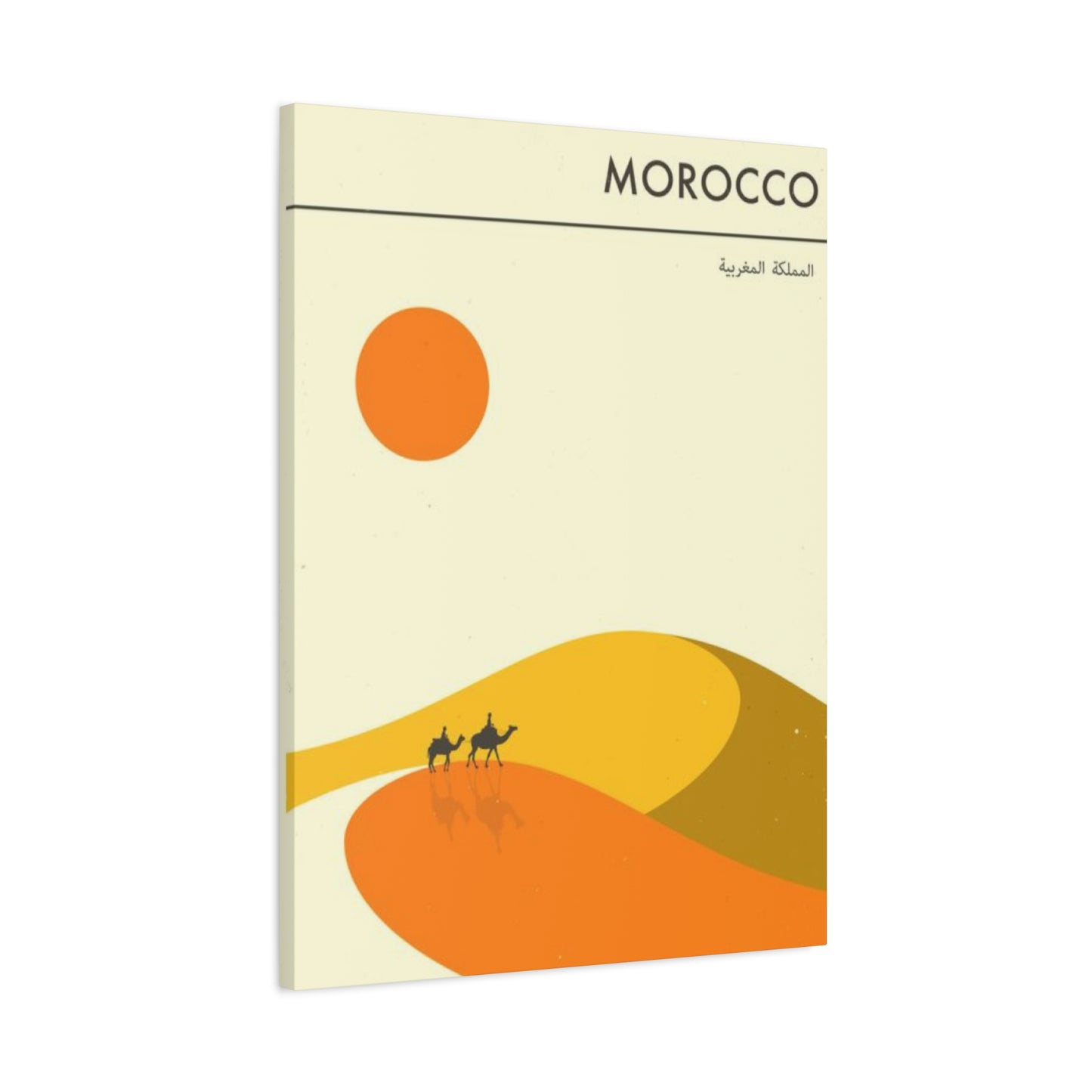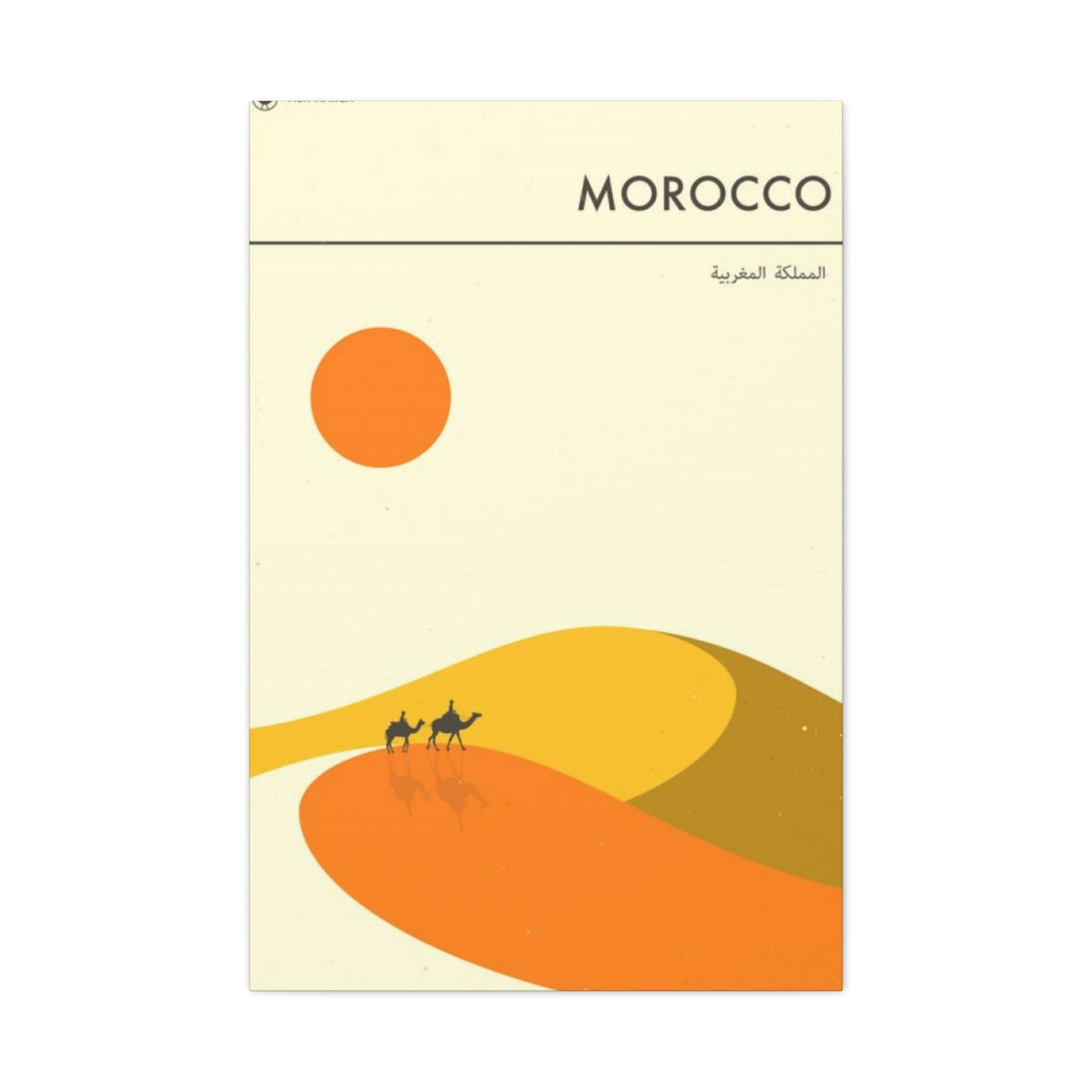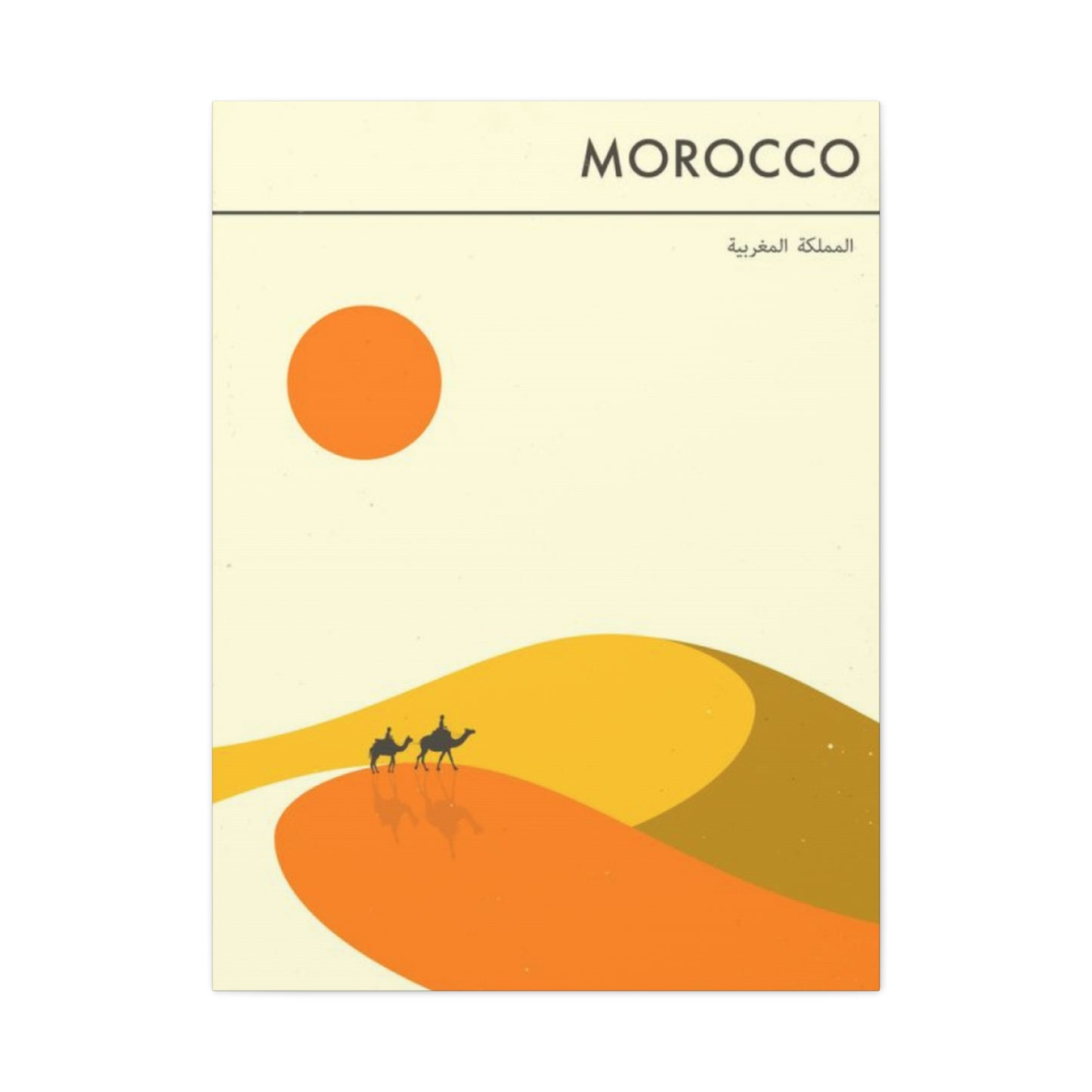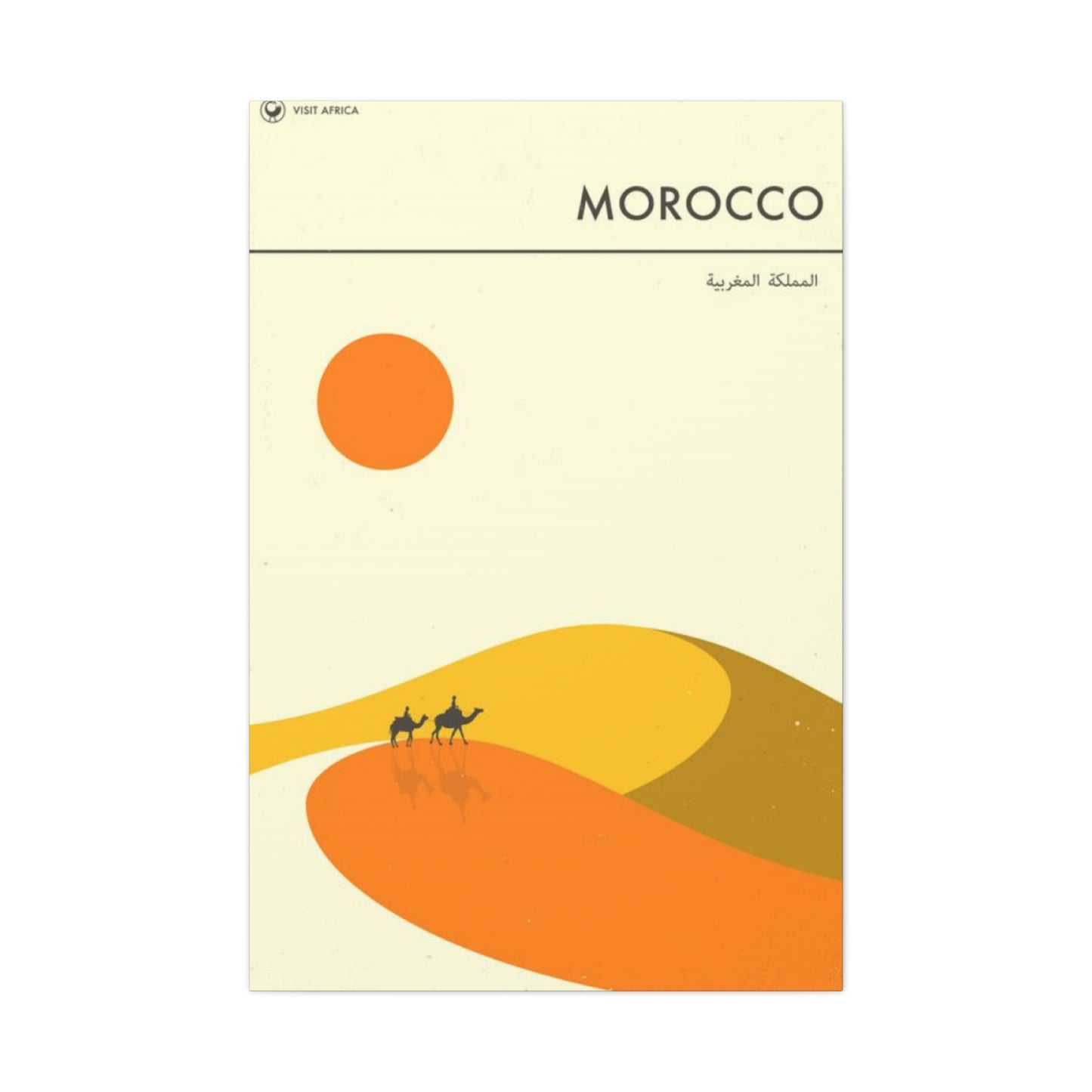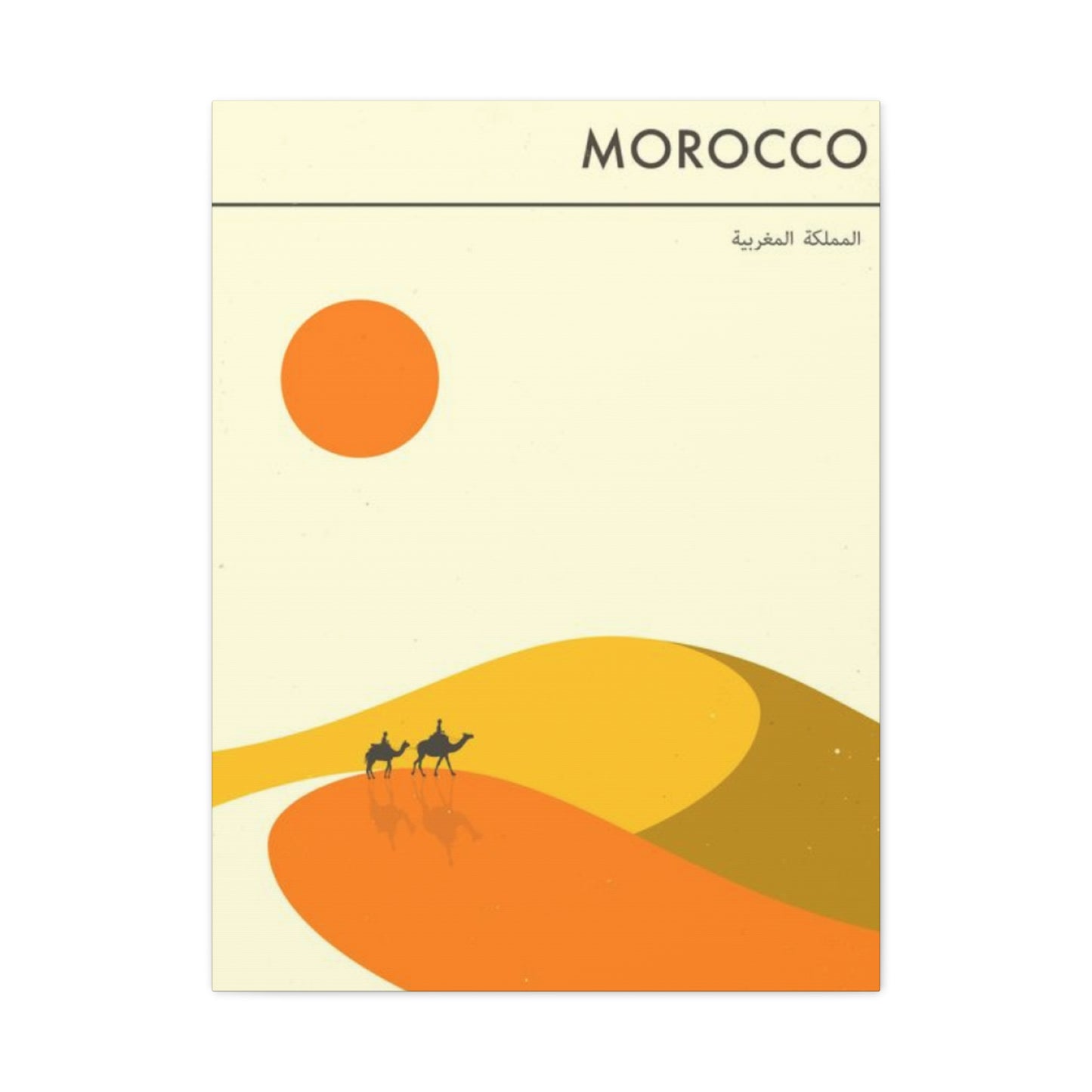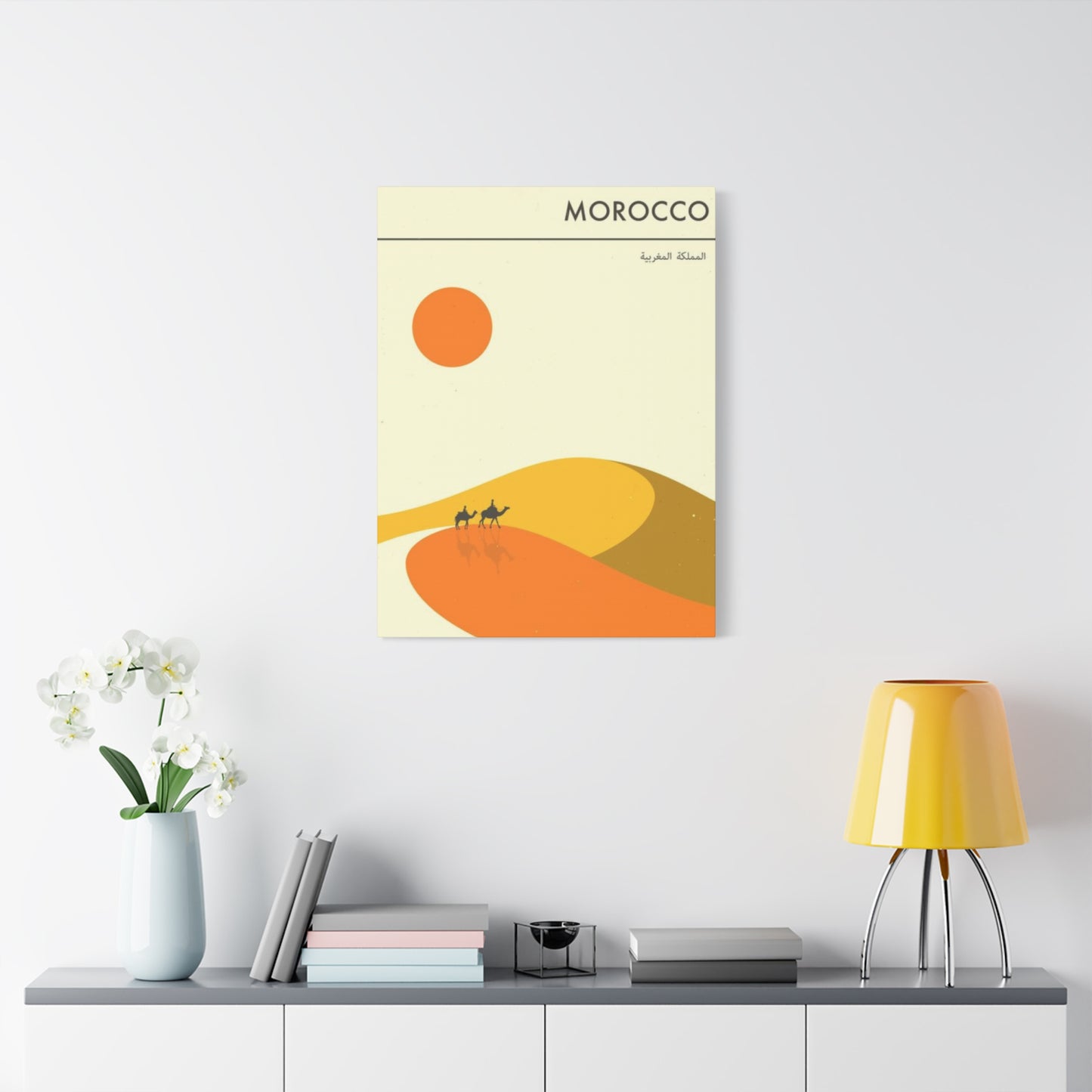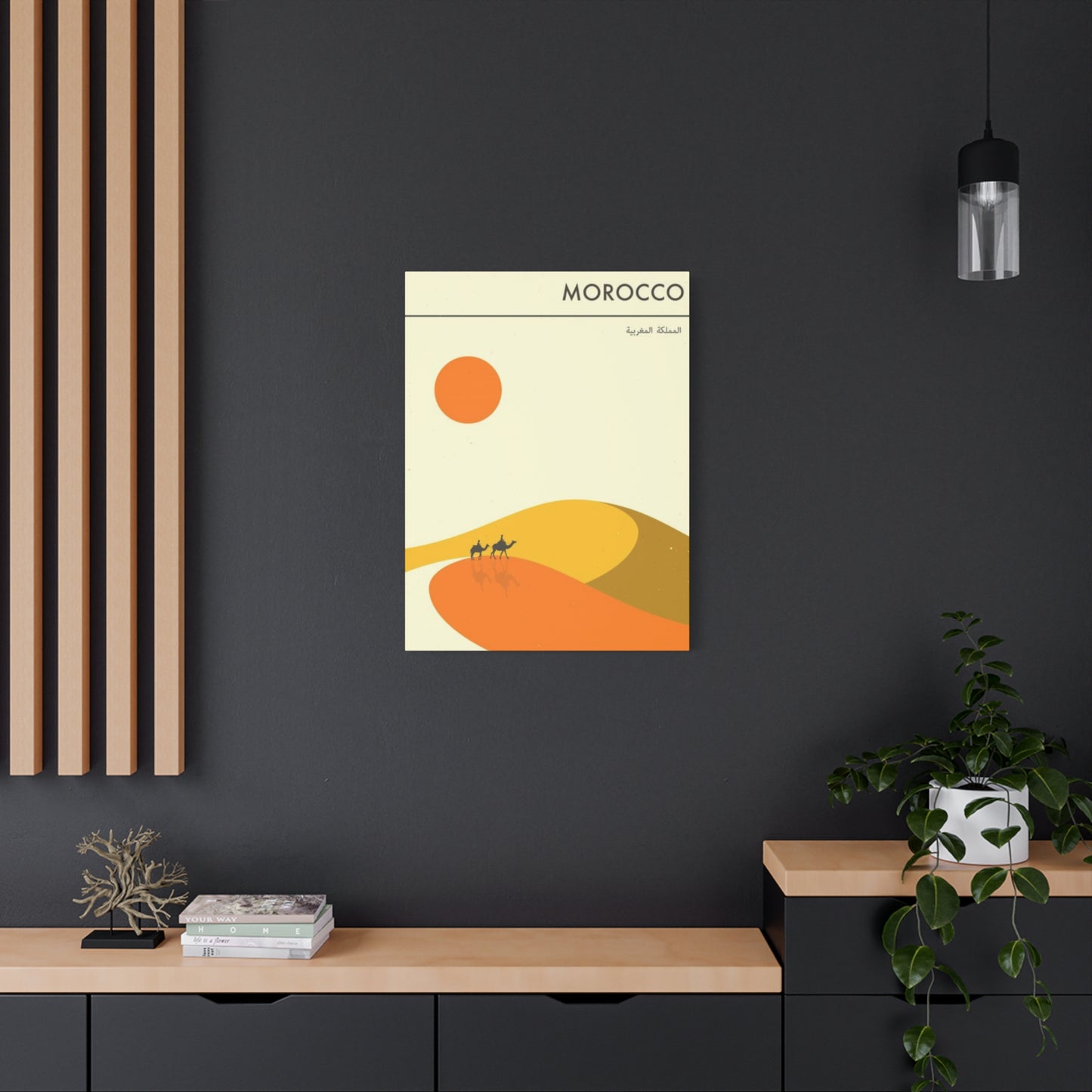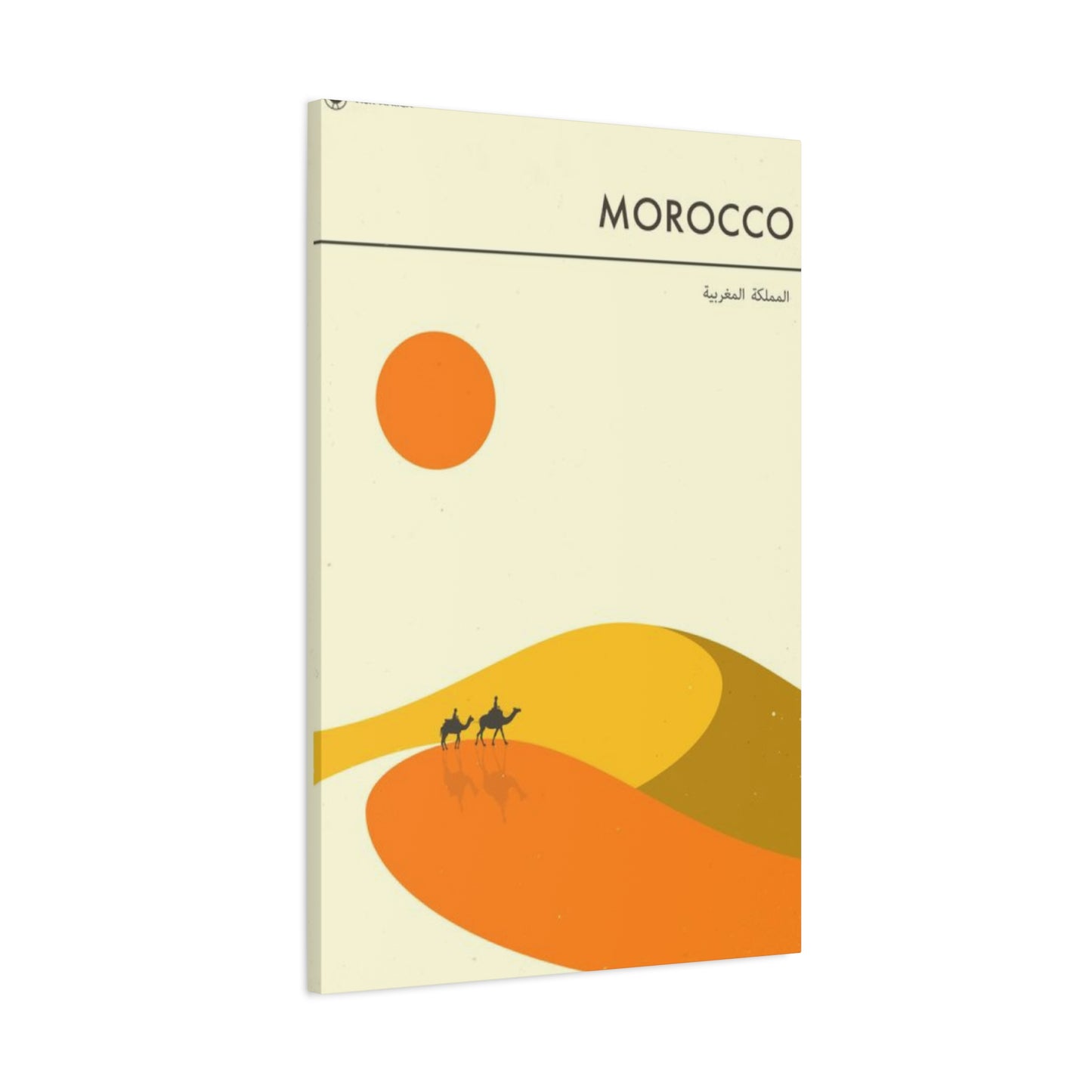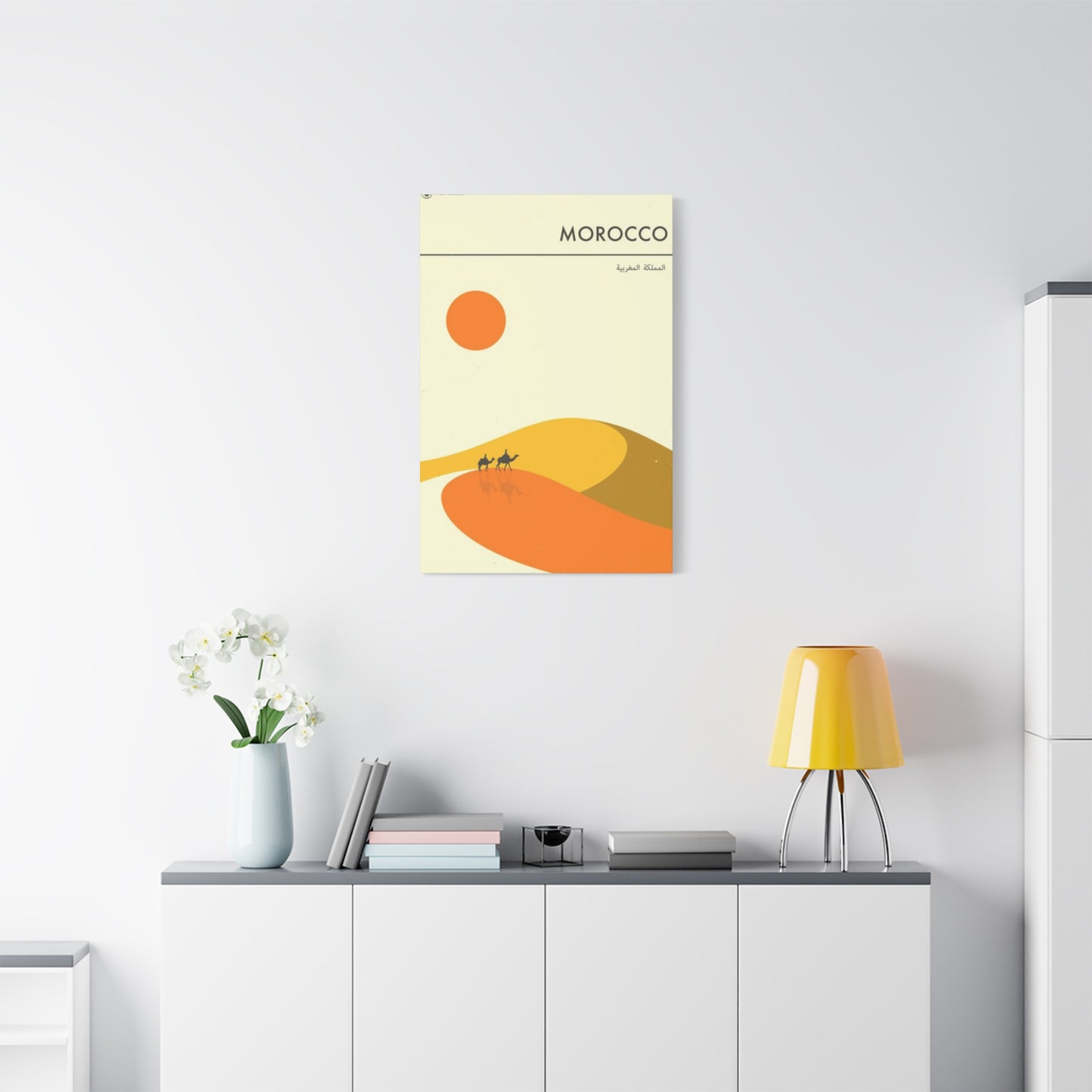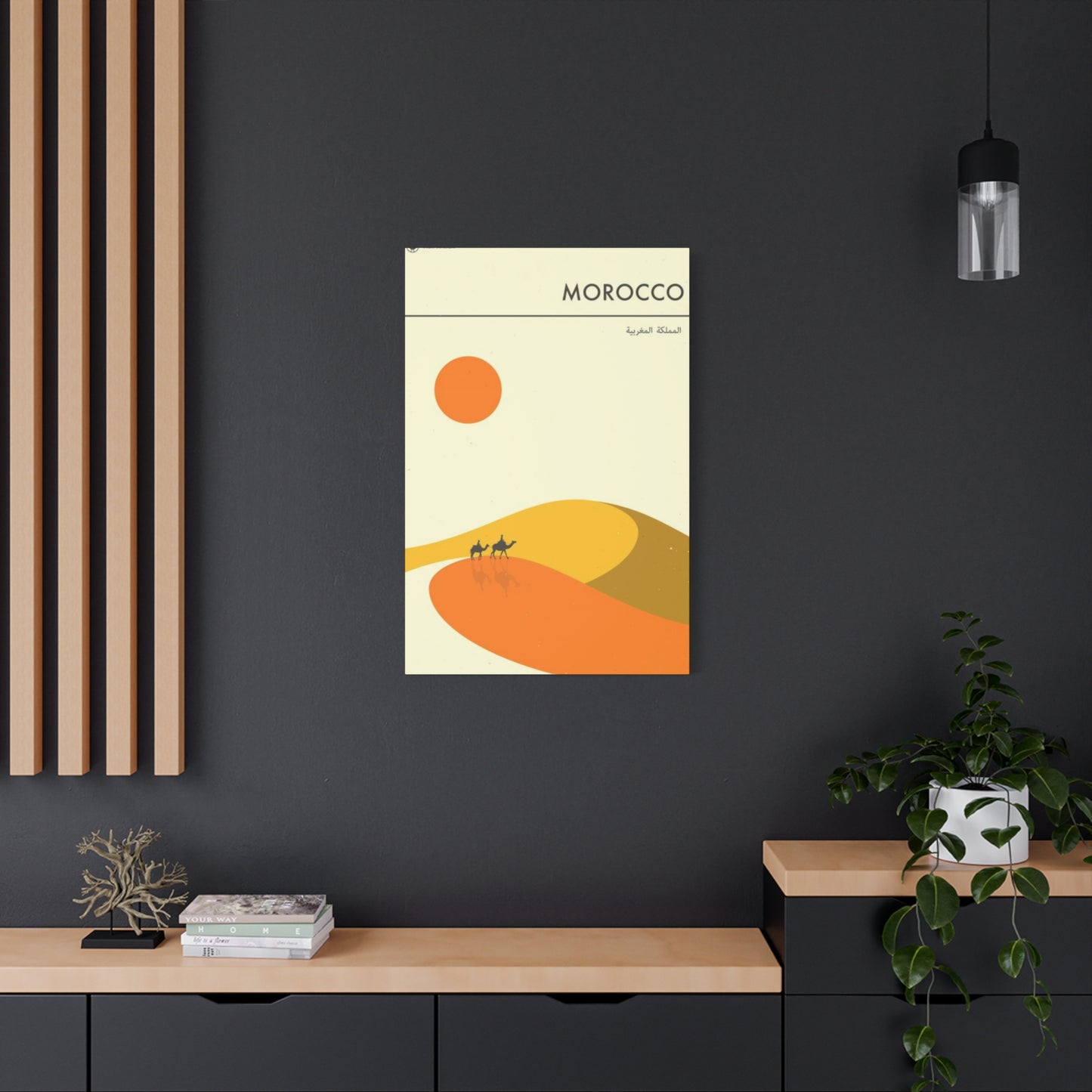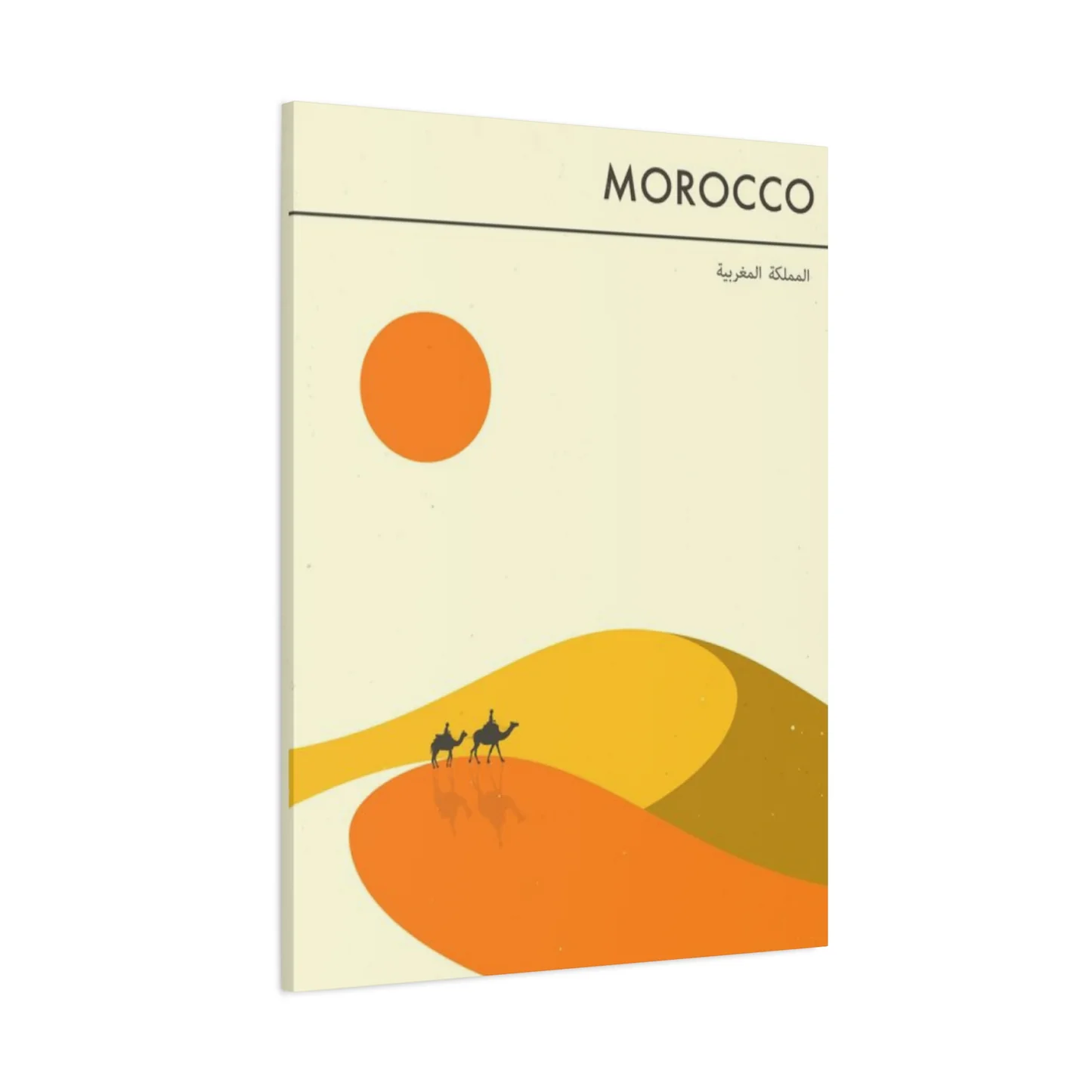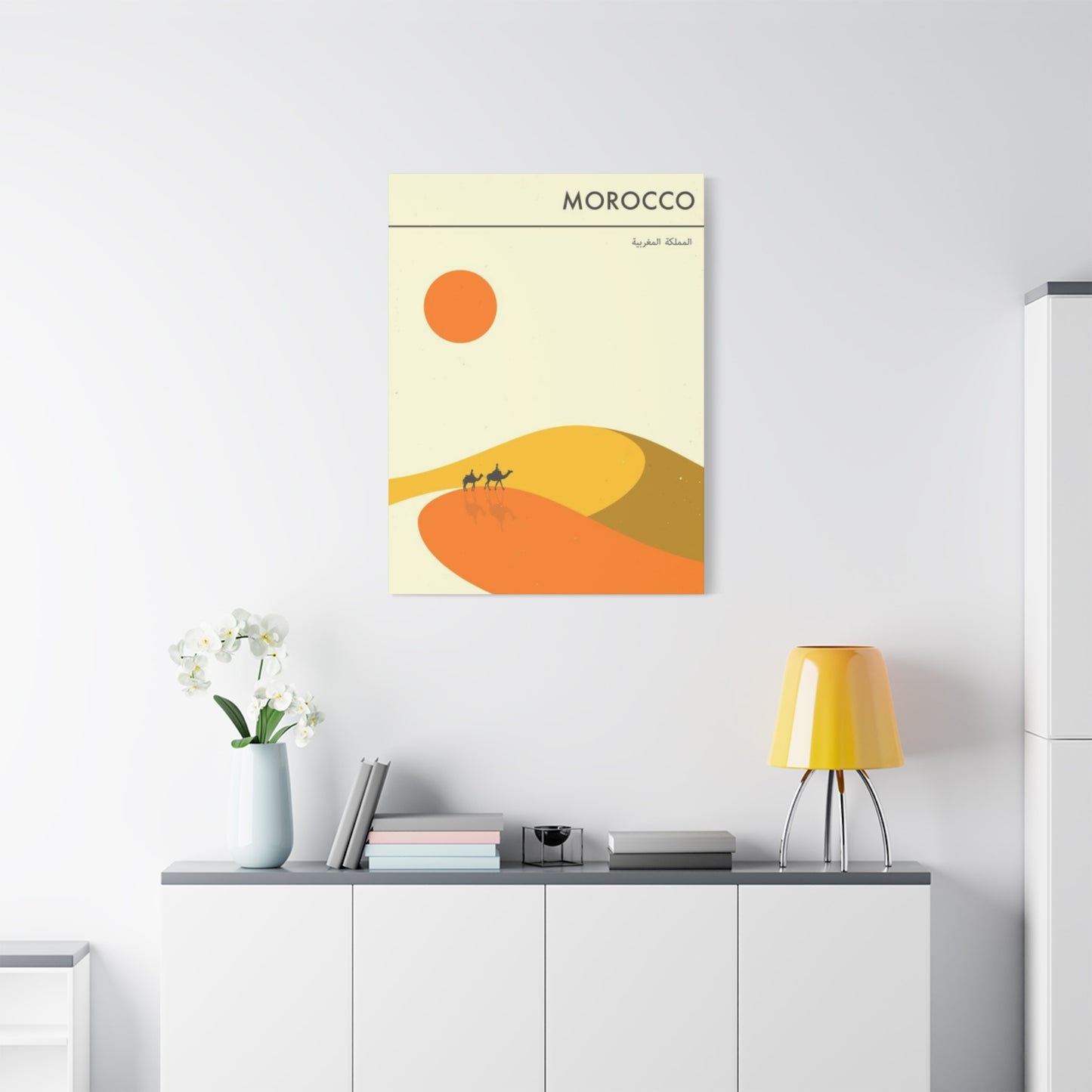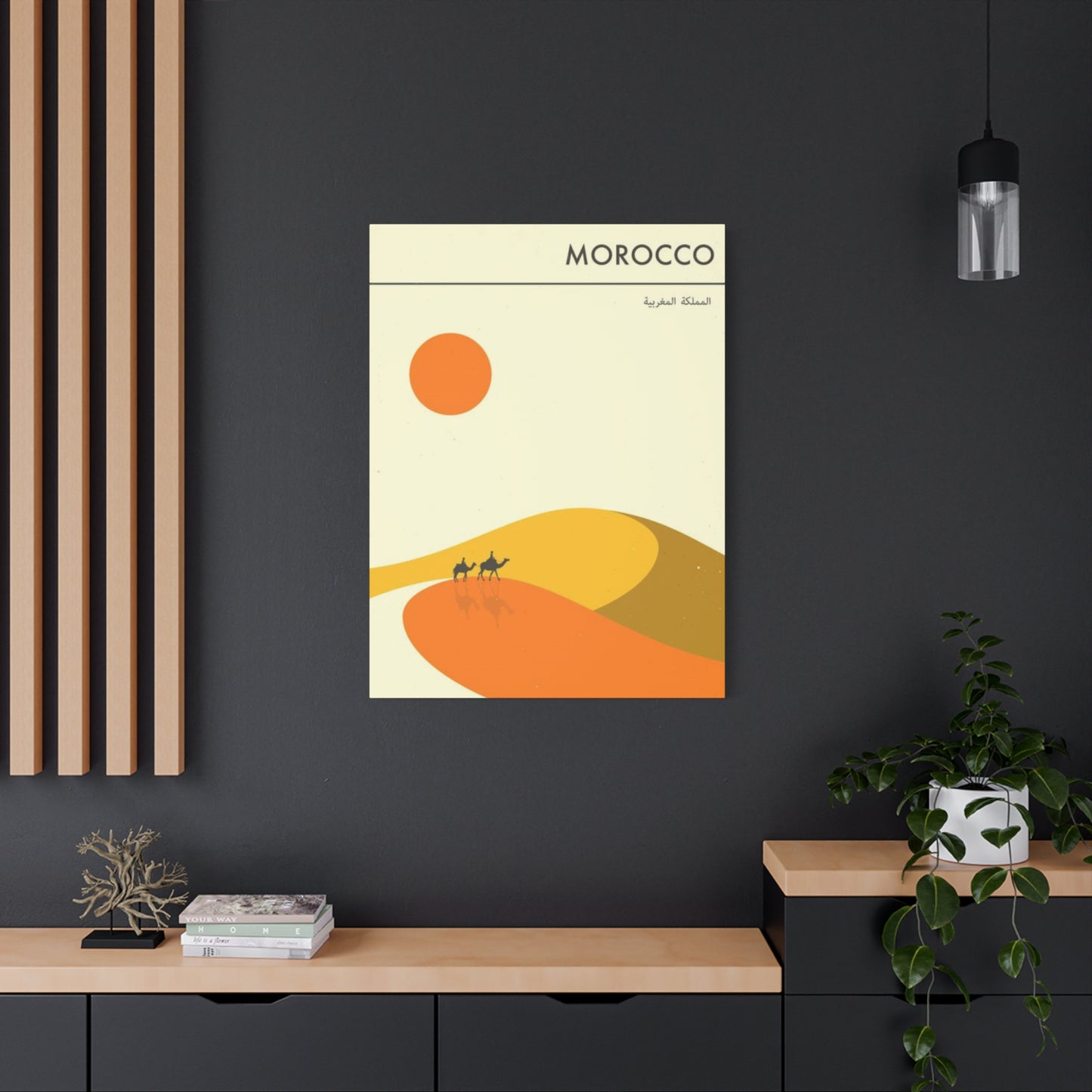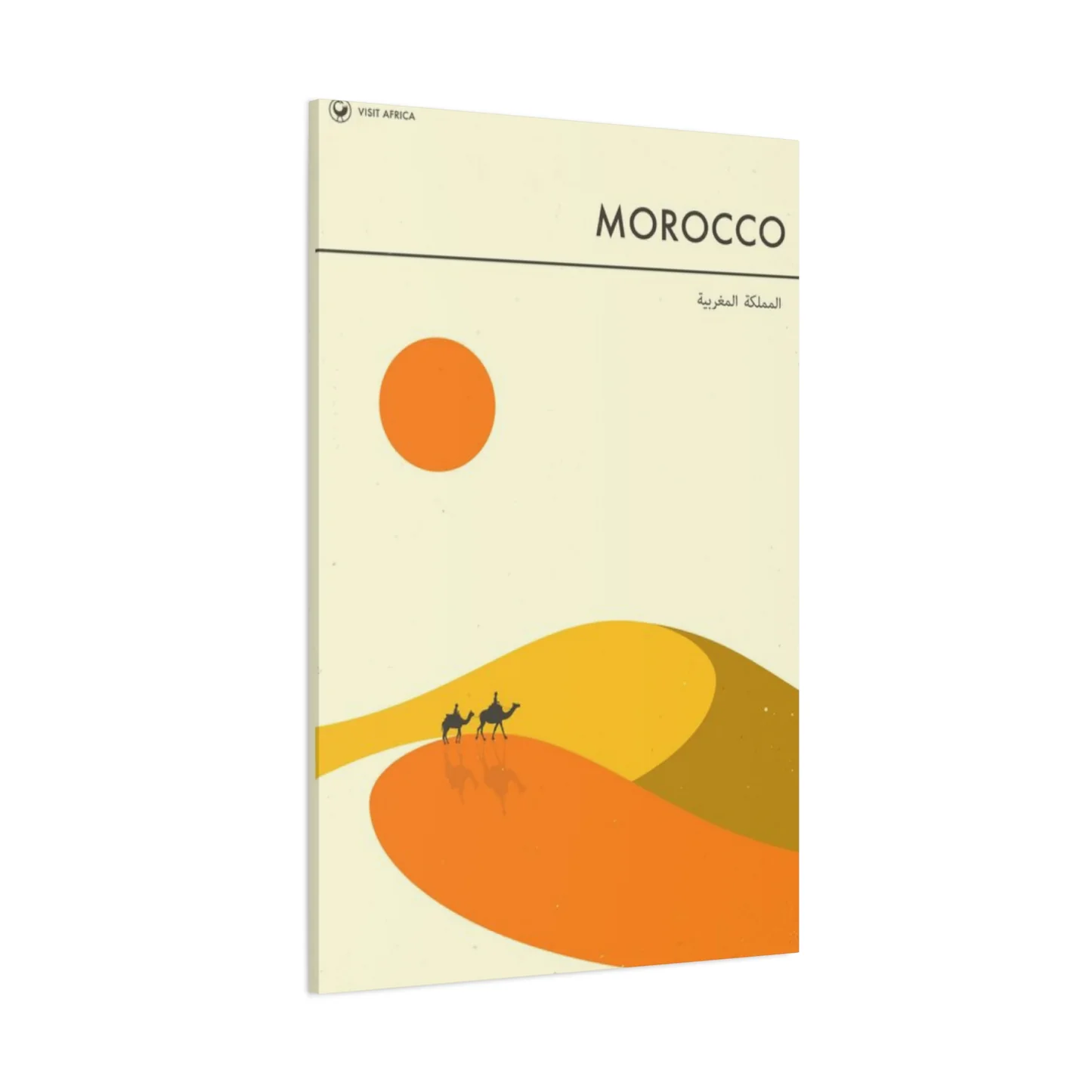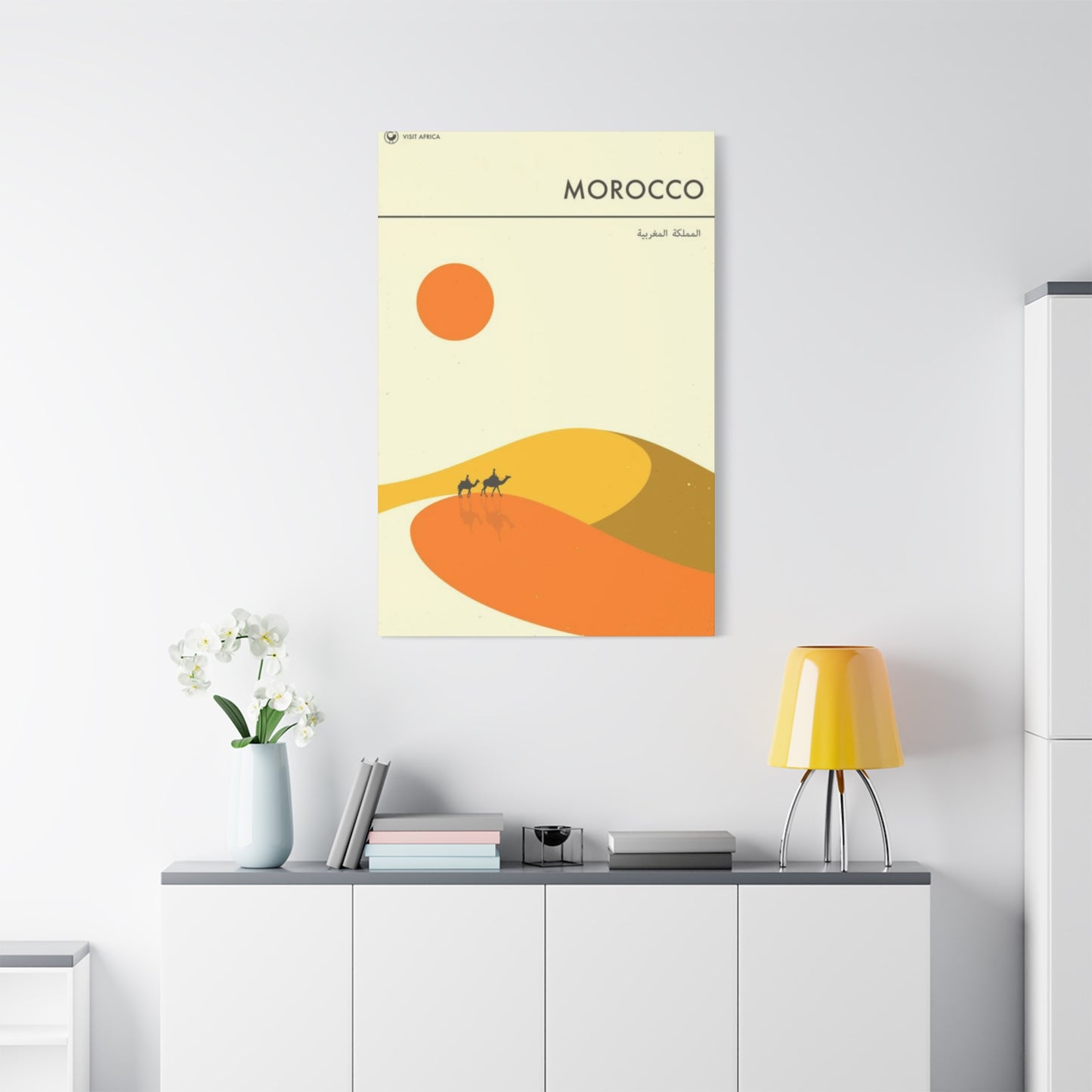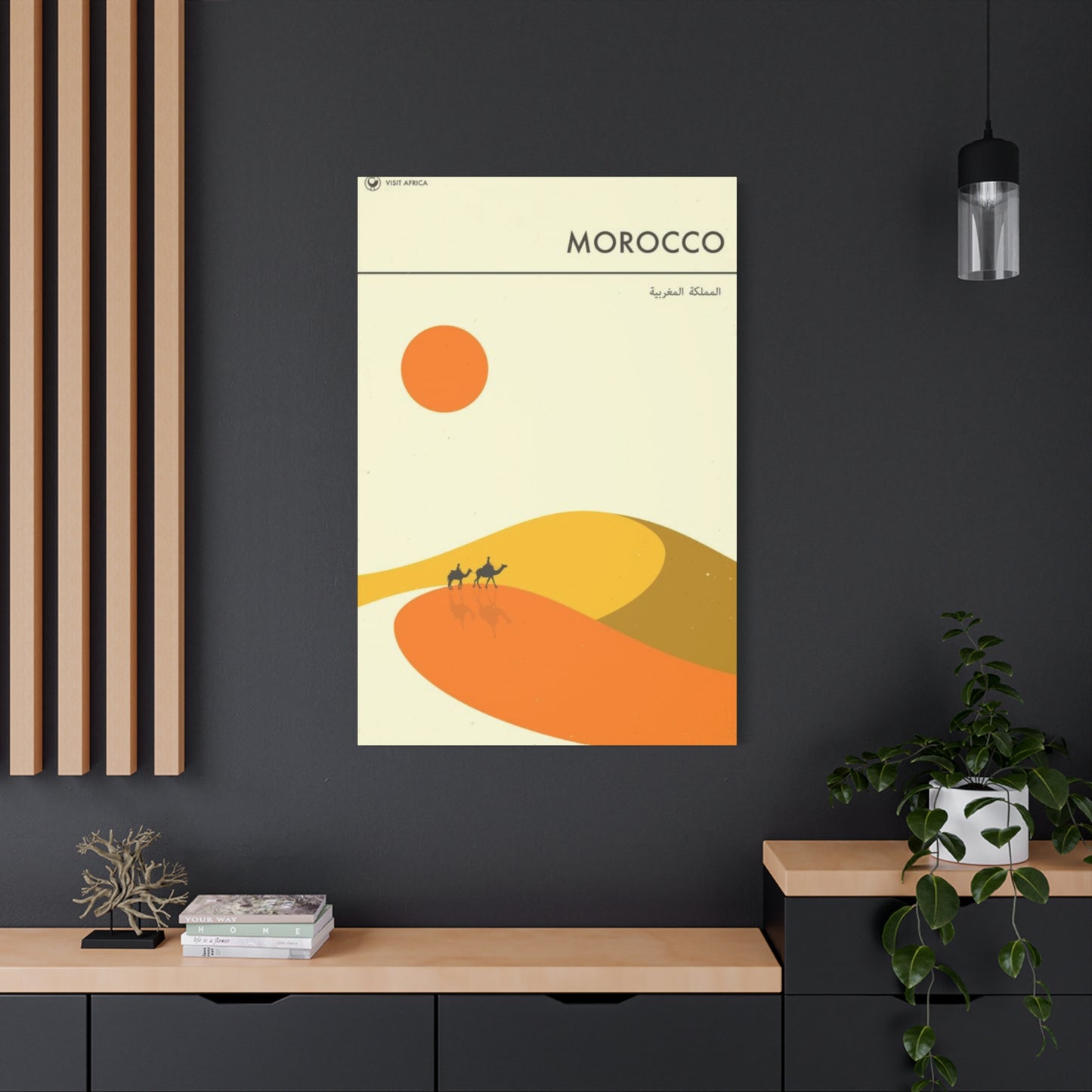Desert Dreams: Exploring the Beauty of Sand Dunes in Moroccan Wall Art
The captivating beauty of North African landscapes has long inspired artists and interior designers worldwide. Among the most striking natural phenomena are the rolling sand formations found throughout Morocco's vast desert regions. These magnificent geological features have become a popular subject for home decoration, offering homeowners an opportunity to bring the serene ambiance of the Sahara into their living spaces. The warm golden hues, dramatic shadows, and undulating patterns created by wind-swept sands provide endless visual interest that can enhance virtually any room in your home.
When considering ways to refresh your interior design, incorporating artwork that features these distinctive desert landscapes can create a focal point that sparks conversation while establishing a calming atmosphere. The natural earth tones found in these scenes blend seamlessly with a wide variety of color palettes, from neutral schemes to bold contemporary arrangements. Whether you're drawn to the minimalist aesthetic or prefer layered, eclectic spaces, artwork depicting these sandy expanses offers remarkable versatility.
The increasing popularity of this decorating trend reflects a broader movement toward bringing natural elements indoors. As people spend more time in their homes, there's a growing desire to create environments that feel both peaceful and connected to the wider world. Artwork featuring these desert vistas satisfies this need beautifully, offering a window into one of nature's most spectacular environments without requiring actual travel.
Throughout this comprehensive exploration, we'll examine numerous approaches to incorporating this distinctive artwork into your home. From selecting the perfect piece for your entryway to creating a cohesive gallery wall in your living room, you'll discover practical strategies for making these stunning images work in your unique space. We'll discuss various artistic styles, framing options, size considerations, and placement techniques that can help you achieve professional-looking results regardless of your decorating experience.
Additionally, we'll explore how these pieces can complement different interior design philosophies, from mid-century modern to bohemian, farmhouse to industrial. The adaptability of this artwork makes it suitable for nearly any aesthetic preference, and understanding how to leverage its natural qualities can help you create spaces that feel intentionally designed rather than randomly decorated.
Creative Approaches to Displaying Desert Landscape Artwork
When incorporating imagery of sweeping sandy landscapes into your home, the possibilities extend far beyond simply hanging a single piece on an empty wall. The most impactful presentations often involve thoughtful consideration of the artwork's relationship to its surroundings, including furniture placement, lighting conditions, and complementary decorative elements.
One effective strategy involves creating a cohesive visual narrative throughout your home by selecting multiple pieces that share similar color temperatures or compositional elements. For example, you might choose several images featuring warm amber tones and consistent lighting conditions, then display them in adjacent rooms or along a hallway. This approach creates visual flow and makes your entire home feel more intentionally designed.
Another consideration is the scale of the artwork relative to the wall space and surrounding furniture. A common mistake is selecting pieces that are too small for the available wall area, which can make the artwork feel insignificant and leave the space feeling unfinished. As a general guideline, artwork should occupy approximately two-thirds to three-quarters of the width of the furniture piece it hangs above. For standalone wall presentations without furniture below, larger formats often create more dramatic impact.
The frame selection also plays a crucial role in how the artwork integrates with your existing decor. Natural wood frames in warm finishes complement the earthy tones found in desert imagery, while sleek metal frames in brass or copper can add a contemporary edge. For a more budget-friendly approach, simple gallery-style black or white frames provide clean lines that allow the imagery to take center stage without competing for attention.
Lighting deserves special attention when displaying this type of artwork. Because the images often feature dramatic natural lighting with strong contrasts between light and shadow, proper illumination can significantly enhance their visual impact. Picture lights mounted directly above the frame, track lighting aimed at appropriate angles, or even natural light from nearby windows can all work effectively, depending on your space configuration and personal preferences.
Consider also the viewing distance and height at which you hang the artwork. The center of the piece should typically be positioned at eye level, which is generally around fifty-seven to sixty inches from the floor. However, this can vary based on ceiling height, furniture arrangement, and the specific room function. In dining rooms where people are typically seated, you might hang pieces slightly lower to ensure they're easily visible from a seated position.
Grouping multiple pieces together creates opportunities for interesting visual compositions. You might arrange three pieces of varying sizes in a triangular pattern, create a horizontal line of uniformly sized prints, or develop a more organic salon-style arrangement with pieces of different dimensions. When grouping artwork, maintaining consistent spacing between frames helps create a polished, professional appearance. A spacing of two to four inches between frames typically works well for most arrangements.
The color of your walls significantly influences how the artwork is perceived. Neutral backgrounds in shades of white, cream, beige, or soft gray allow the warm tones in desert imagery to stand out beautifully. However, darker wall colors can create stunning contrast, particularly with images featuring bright sunlit sands against deep blue skies. Don't be afraid to experiment with wall color if you're willing to make that investment.
Textural elements in your space can enhance the overall effect. Incorporating woven textiles, natural fiber rugs, leather furnishings, or raw wood accents creates connections between the artwork and the physical environment, making the design feel more cohesive. These tactile elements echo the natural qualities present in the imagery, strengthening the overall aesthetic impact.
Bringing Desert Atmosphere into Your Home
Creating an interior environment that captures the essence of arid landscapes involves more than simply hanging appropriate artwork. It requires a holistic approach that considers color, texture, pattern, and the overall mood you want to establish in each space. The goal is to evoke the feeling of these expansive natural environments while maintaining the comfort and functionality necessary for daily living.
Color palette selection forms the foundation of this decorating approach. The natural hues found in sandy terrain range from pale cream and soft beige to rich terracotta and deep rust. These warm neutrals create a soothing backdrop that promotes relaxation while remaining sophisticated enough for formal spaces. When building your color scheme, consider using lighter shades as your dominant colors, with deeper tones as accents to create depth and visual interest.
Incorporating these earth-inspired hues doesn't mean every surface must be beige. Rather, think about layering different shades and introducing complementary colors that appear in desert environments at different times of day. The soft lavenders and deep purples visible at sunset, the brilliant oranges and pinks of sunrise, or the cool blue-grays of distant mountains can all be incorporated as accent colors through accessories, textiles, or smaller decorative elements.
Natural materials play a crucial role in establishing authentic desert-inspired interiors. Wood furnishings in medium to dark finishes provide grounding elements, while lighter woods or bamboo add airiness. Stone elements, whether in fireplace surrounds, accent walls, or decorative objects, reference the rocky outcroppings found throughout desert regions. Clay pottery, ceramic vessels, and terracotta planters all contribute to the overall aesthetic while providing functional storage or display opportunities.
Textile selections offer another avenue for reinforcing the desert theme. Natural fibers such as linen, cotton, jute, and sisal bring organic texture into the space. Consider window treatments in lightweight, natural fabrics that filter sunlight softly, mimicking the quality of light in desert environments. Area rugs in neutral tones with subtle geometric patterns or natural textures anchor seating areas while providing comfort underfoot.
Metallic accents in warm finishes add subtle glamour without overwhelming the natural aesthetic. Brass, copper, and bronze elements in lighting fixtures, hardware, or decorative accessories catch and reflect light in ways that enhance the warm color palette. These materials develop beautiful patinas over time, adding character and depth to your space.
Plants might seem counterintuitive in a desert-inspired space, but many varieties thrive in arid conditions and make excellent decorative elements. Succulents, cacti, and other drought-tolerant species not only look appropriate but also require minimal maintenance. Displayed in simple terracotta or ceramic containers, these living elements add color, texture, and vitality to your interior while reinforcing the connection to desert environments.
Lighting design significantly influences the atmosphere in desert-themed spaces. Multiple light sources at varying heights create depth and allow you to adjust the ambiance throughout the day. Table lamps with natural fiber or ceramic bases, floor lamps with warm-toned shades, and ambient lighting from candles or lanterns all contribute to creating inviting environments. Dimmer switches provide flexibility, allowing you to adapt lighting levels to different activities and times of day.
The principle of negative space, so prominent in desert landscapes where vast empty expanses dominate the visual experience, can inform furniture arrangement and decorative choices. Rather than filling every available surface with objects, allow breathing room between furniture pieces and limit accessories to meaningful items that truly enhance the space. This edited approach creates calm, uncluttered environments that feel spacious and serene.
Artwork Featuring Saharan Scenery for Different Rooms
Each room in your home presents unique opportunities and challenges for displaying artwork. Understanding the specific function, traffic patterns, and existing design elements in each space helps you select and position pieces for maximum impact. The versatility of desert landscape imagery makes it suitable for virtually any room, but thoughtful consideration of each space's particular characteristics ensures the most successful results.
Kitchen spaces might not immediately come to mind as locations for significant artwork, but they offer excellent opportunities for incorporating smaller pieces or collections. Above-cabinet displays, on walls adjacent to dining areas, or in breakfast nooks, these images can soften the hard surfaces typically found in kitchens while adding warmth. Given potential exposure to moisture and temperature fluctuations, choose appropriately sealed pieces or consider reproductions rather than valuable originals in these spaces.
Bathroom environments present similar considerations regarding moisture and temperature. However, powder rooms with less humidity can successfully accommodate artwork, transforming these small spaces into memorable experiences for guests. A single striking image above the vanity or opposite the entry creates an immediate focal point. The warm tones complement common bathroom materials like stone, tile, and wood vanities beautifully.
Home offices benefit from artwork that promotes focus and creativity without being overly stimulating. Desert landscapes offer the perfect balance, providing visual interest during moments of mental rest while maintaining the calm necessary for concentration. Position artwork within your line of sight when looking up from your computer screen, giving your eyes a natural resting point during work sessions. The expansive quality of these images can help small office spaces feel larger and less confining.
Children's rooms or nurseries can incorporate gentler interpretations of this theme. Soft, watercolor-style renderings or simplified graphic versions of desert scenes create age-appropriate focal points that won't overstimulate young minds. As children grow, the artwork remains sophisticated enough to transition through different developmental stages without feeling juvenile.
Hallways and staircases provide excellent opportunities for creating gallery-style displays. These transitional spaces often have ample wall area that benefits from visual interest. A series of related images arranged along a hallway creates movement and guides the eye forward. In stairwells, arrange pieces at varying heights to account for the angle of the stairs, ensuring each image is at appropriate eye level as you ascend or descend.
Creating a Welcoming First Impression
The entrance to your home sets the tone for everything that follows, making it an ideal location for impactful artwork. This transitional space bridges the outside world with your private sanctuary, and the decorative choices you make here communicate your personal style to visitors while welcoming you home each day. Artwork featuring expansive desert vistas can create an immediate sense of calm and sophistication in this often-small but important area.
When selecting pieces for entry spaces, consider the available wall area carefully. Large-scale artwork makes a bold statement in spacious foyers, while smaller prints might be more appropriate for compact entryways. The key is ensuring the artwork feels proportionate to the space rather than overwhelming it or getting lost against the wall. Vertical orientations often work particularly well in entries, as they draw the eye upward and can make ceilings feel higher.
The color scheme of your entryway should coordinate with the artwork you select. If your entry features neutral walls and natural wood elements, virtually any desert landscape image will integrate beautifully. However, if you have specific paint colors or wallpaper, choose artwork that complements or intentionally contrasts with these existing elements. The warm tones in desert imagery pair particularly well with cool gray-blues and soft greens, creating balanced color relationships.
Furniture arrangement in the entry should support and enhance the artwork rather than competing with it. A console table positioned below wall art creates a logical grouping, with the artwork serving as the visual anchor. Style the console surface simply, perhaps with a table lamp, decorative bowl for keys, or small plant, keeping the arrangement minimal so attention remains focused on the artwork above.
Lighting in entryways deserves special attention, as these spaces often lack natural light. A combination of ambient lighting from a ceiling fixture and accent lighting directed at the artwork ensures the piece is visible and appreciated regardless of the time of day. Wall sconces flanking the artwork can provide both functional illumination and decorative interest, though placement must be carefully considered to avoid casting awkward shadows on the image.
Mirrors strategically placed in entries can interact interestingly with artwork. A mirror positioned opposite a wall-hung print can reflect the image, creating visual depth and making the space feel larger. Alternatively, grouping a mirror and artwork on the same wall in a thoughtful arrangement combines functionality with aesthetics. Ensure the mirror is positioned to reflect something attractive, whether natural light from a nearby window or a well-styled vignette.
Simplified Aesthetic Approaches
The popularity of minimalist design continues to grow as people seek calm, uncluttered environments that promote mental clarity and relaxation. Desert landscape artwork aligns beautifully with minimalist principles, offering visual interest without overwhelming simplicity. The inherent qualities of these images make them ideal for spaces where less truly is more.
Minimalist interiors typically feature limited color palettes, clean lines, quality over quantity, and intentional negative space. Desert scenes naturally embody many of these characteristics. The gentle gradations of sand tones, the smooth curves of dune formations, and the expansive empty sky all reflect minimalist sensibilities. When selecting artwork for minimalist spaces, choose images with uncluttered compositions that feature subtle color variations rather than dramatic contrasts.
Single large-scale pieces often work better in minimalist settings than collections of smaller prints. One substantial image creates impact through scale and presence rather than through multiplication of elements. This approach maintains the simplified aesthetic while providing sufficient visual interest to prevent the space from feeling stark or incomplete. Consider oversized formats that make bold statements without requiring additional supporting pieces.
Framing choices for minimalist presentations should emphasize simplicity. Thin metal frames in black or white, natural wood frames with minimal profiles, or even frameless mounting systems all support clean aesthetic goals. The frame should protect and present the artwork without drawing attention to itself as a separate decorative element. Mat boards, if used, should be simple and neutral, allowing the image to remain the clear focus.
Furniture selection in minimalist spaces follows similar principles. Pieces with clean lines, simple forms, and neutral colors provide functionality without visual clutter. Low-profile sofas, streamlined tables, and storage solutions that conceal rather than display belongings all contribute to the overall aesthetic. The artwork becomes one of few decorative elements in the space, increasing its impact and importance.
Color palettes in minimalist interiors often feature whites, grays, and blacks with occasional natural wood tones. This neutral foundation allows artwork featuring warm desert hues to introduce color without overwhelming the space. The contrast between cool neutral backgrounds and warm artwork creates dynamic visual relationships that energize the space while maintaining overall simplicity.
Textile selections support minimalist goals when kept simple in pattern and limited in quantity. Solid colors or subtle textures work better than bold patterns or multiple competing prints. Natural materials like linen, cotton, and wool provide warmth and comfort without adding visual complexity. Window treatments should be simple and functional, perhaps consisting of plain Roman shades or sheer panels that filter light softly.
Traditional and Rustic Interior Approaches
While contemporary and minimalist styles dominate current design trends, traditional and rustic aesthetics maintain strong appeal for those seeking warmth, character, and connection to historical design traditions. Desert landscape artwork integrates beautifully into these more traditional spaces, adding natural elements that complement rather than contradict established design principles.
Rustic interiors emphasize natural materials, handcrafted elements, and connection to the outdoors. The organic qualities inherent in desert imagery align perfectly with these values. Images of wind-swept sand formations speak to the power of natural forces and the beauty of untamed landscapes. When incorporated into rustic spaces, this artwork reinforces the overall commitment to celebrating natural beauty and authentic materials.
Frame selection for rustic presentations offers opportunities to introduce additional texture and character. Reclaimed wood frames with visible grain patterns, distressed finishes, or even frames crafted from weathered barn wood all enhance the rustic aesthetic. The imperfections in these frames add character that complements the natural subject matter of the artwork. Wider frame profiles typical of rustic design provide substantial visual weight appropriate for spaces featuring heavy furniture and bold architectural elements.
Color palettes in rustic interiors tend toward warm earth tones, making them natural companions for desert landscape artwork. Deep browns, rich terracottas, warm creams, and forest greens create inviting environments that feel grounded and comfortable. The golden and amber tones in desert imagery blend seamlessly into these color schemes, adding variation while maintaining overall harmony.
Furniture in rustic spaces typically features substantial construction, visible wood grain, and classic forms. Large wooden tables, overstuffed upholstered seating, and solid case goods create environments that feel permanent and rooted. Against this backdrop, artwork becomes a softening element, introducing organic curves and visual lightness that balance the weightiness of furnishings.
Architectural elements common in rustic interiors provide excellent contexts for displaying artwork. Exposed wooden beams, stone fireplaces, and plank walls all create natural focal points around which to arrange decorative elements. Artwork positioned above a mantel, between windows, or on a feature wall receives automatic emphasis from these architectural anchors.
Creating Depth Through Decorative Layering
Advanced decorating techniques often involve layering multiple elements to create visual depth, texture, and interest. This approach, sometimes called collected or curated style, appears effortless but actually requires careful consideration of scale, color, texture, and balance. Desert landscape artwork serves as an excellent foundation for layered presentations, providing a substantial backdrop against which other elements can play.
The principle of layering begins with establishing a focal point, typically a substantial piece of artwork. This anchor piece should be significant enough to hold attention and large enough to make a statement. From this foundation, additional elements are introduced at varying distances from the wall, creating dimensional interest. Objects might be leaned against the wall at the base of the artwork, smaller frames or mirrors layered in front of larger pieces, or three-dimensional objects arranged on surfaces below or adjacent to the art.
Scale variation is crucial in successful layering. Combining elements of different sizes creates visual movement and prevents monotony. A large primary piece might be accompanied by several smaller supporting elements, or medium-sized pieces might be arranged with both larger and smaller accent items. The eye should move comfortably between different scales, finding points of rest and moments of interest throughout the arrangement.
Color relationships in layered presentations require thoughtful consideration. While variety adds interest, too many competing colors create chaos rather than cohesion. Using the colors present in the primary artwork as a guide for selecting additional elements ensures harmony. If the main piece features warm golds and soft browns, supporting elements might incorporate these tones along with complementary colors like soft blues or muted greens.
Textural variety enhances layered presentations by engaging multiple senses. The smooth surface of framed artwork might be contrasted with rough stone, woven textiles, hammered metal, or glazed ceramics. These textural differences create richness and depth that prevent arrangements from feeling flat or one-dimensional. The interplay of smooth and rough, shiny and matte, soft and hard adds complexity that rewards closer inspection.
Symmetrical versus asymmetrical arrangements each offer distinct advantages in layered presentations. Symmetrical arrangements feel formal, ordered, and intentional. They work particularly well in traditional spaces or on prominent architectural features like fireplace mantels. Asymmetrical arrangements feel more casual, organic, and collected. They're ideal for creating gallery walls or styling console tables in contemporary spaces.
The concept of negative space remains important even in layered presentations. Every surface need not be covered, and some breathing room between elements prevents the arrangement from feeling cluttered or overwhelming. The negative space provides visual rest and allows each individual element to be appreciated rather than getting lost in an overly busy composition.
Practical considerations include ensuring stability and safety in layered arrangements. Items leaning against walls should be secured appropriately to prevent tipping. Arrangements on high surfaces should avoid top-heavy configurations that might topple. If you have young children or pets, accessibility and durability become additional important factors in planning layered presentations.
Layering creates opportunities for seasonal updates and refreshing without major overhaul. The primary artwork remains constant, providing continuity, while smaller supporting elements can be rotated to reflect seasonal changes or evolving tastes. This flexibility allows your space to feel current and dynamic without requiring significant investment or effort.
Making Bold Visual Statements
While subtle, understated decor has its place, sometimes spaces benefit from bold, confident design choices that command attention and establish strong aesthetic identities. Large-scale desert landscape artwork can serve as such a statement piece, transforming ordinary rooms into memorable spaces that reflect personal style and creative vision.
Oversized artwork creates immediate impact through sheer physical presence. Pieces measuring three, four, or even five feet across dominate wall space and become undeniable focal points. This scale works particularly well in spaces with high ceilings, large open floor plans, or prominent architectural features that can balance the visual weight. The expansive nature of desert imagery lends itself beautifully to large formats, where details and subtle tonal variations become fully appreciable.
Triptychs and multi-panel presentations offer alternatives to single large pieces while achieving similar impact. Three related images hung side by side create horizontal emphasis and work well above long furniture pieces like sofas or sideboards. The slight separation between panels adds visual interest while the unified subject matter maintains cohesion. This format also offers practical advantages in spaces where maneuvering a single enormous piece would be challenging.
Unconventional proportions create striking visual statements. Extra-wide panoramic formats emphasize horizontal lines and work beautifully above low-profile furniture. Extremely vertical pieces draw the eye upward, making ceilings feel higher and narrow spaces feel less cramped. These unusual proportions stand out specifically because they deviate from standard rectangular formats people expect.
Bold framing choices amplify impact. While simple frames often disappear into the background, substantial frames in distinctive finishes become part of the overall statement. Wide rustic wood frames, ornate gilded frames, or frames in unexpected colors transform artwork presentations from simple wall decor into significant design features. The key is ensuring the frame complements rather than competes with the imagery.
Unconventional placement creates memorable impressions. While most artwork hangs at standard eye level on obvious walls, creative positioning can yield dramatic results. Floor-leaning pieces casually propped against walls suggest collected, gallery-style aesthetic. Artwork extending down from the ceiling or positioned unusually high draws attention through unexpected placement. Pieces hung in non-traditional locations like above doorways or in corners surprise and delight.
Lighting designed specifically to showcase artwork intensifies its impact. Picture lights mounted directly to frames, track lighting aimed precisely, or even colored accent lighting can transform how artwork is perceived. Dramatic lighting creates theater-like presentations that emphasize the artwork as a significant design investment worthy of special attention.
Refreshing Private Retreats
Bedrooms serve as personal sanctuaries where we begin and end each day, making them ideal candidates for thoughtful, intentional decorating. The calming qualities of desert landscape artwork align perfectly with bedroom functions, promoting relaxation and providing pleasant visual focal points that contribute to restful environments.
Positioning artwork in bedrooms requires consideration of bed placement and sight lines. The wall behind the bed, often the room's most prominent feature, naturally accommodates significant artwork. A large single piece or unified collection positioned above the headboard creates a clear focal point visible upon entering the room. Scale should be appropriate to the bed size, with the artwork spanning a substantial portion of the wall width without appearing cramped or overwhelming.
Alternative positioning places artwork on walls opposite or adjacent to the bed, visible from the sleeping position. This placement allows you to enjoy the artwork while lying in bed, potentially the last thing you see before sleeping and first thing upon waking. Images featuring serene, calming compositions work particularly well in these locations, contributing to the peaceful atmosphere conducive to quality rest.
Color psychology plays an important role in bedroom design. The warm, earthy tones found in desert landscapes generally promote feelings of security, comfort, and connection to nature. These colors don't typically stimulate or energize the way bright, saturated hues might, making them appropriate for spaces dedicated to rest and relaxation. The subtle color variations in sand and sky provide visual interest without overwhelming the senses.
Bedroom furniture arrangement should complement rather than compete with artwork. In smaller rooms, keep furniture profiles low to prevent blocking artwork or making the space feel crowded. In larger rooms, substantial furniture pieces can be balanced with appropriately scaled artwork. Nightstands, dressers, and seating should be positioned to create conversation with the artwork rather than treating it as an afterthought.
Lighting in bedrooms serves multiple functions and should be planned accordingly. Bright overhead lighting provides functionality for dressing and cleaning, while softer ambient lighting creates relaxing evening atmosphere. Bedside lamps allow for reading without fully illuminating the room. If artwork is significant, consider dedicated accent lighting that can be controlled separately, allowing you to highlight the piece while keeping overall room lighting low and conducive to sleep.
Window treatments influence both the lighting conditions and overall aesthetic in bedrooms. Blackout curtains or shades promote quality sleep by blocking exterior light, but during waking hours, consider how natural light interacts with your artwork. Sheer underlayers allow gentle natural light to filter in while maintaining privacy, creating soft, flattering illumination that enhances warm-toned artwork.
Textile selections in bedrooms offer opportunities to reinforce the desert aesthetic suggested by your artwork. Bedding in neutral tones with subtle texture provides visual calm. Throw pillows might introduce accent colors pulled from the artwork, creating cohesive color relationships. Area rugs in natural fibers or subtle patterns add warmth underfoot while complementing the overall design scheme.
Drawing Inspiration from Journeys
One of the most compelling aspects of incorporating desert landscape imagery into home decor stems from the connection to travel experiences and memories of places visited. Whether you've personally explored these magnificent landscapes or dream of future adventures, artwork can serve as a tangible reminder of experiences and aspirations, adding layers of personal meaning beyond pure aesthetic appeal.
For those fortunate enough to have traveled to desert regions, artwork depicting similar landscapes becomes more than mere decoration. It's a memory trigger, instantly transporting you back to the feelings and experiences associated with those journeys. The warmth of the sun, the texture of sand, the vastness of the sky, all return when you look at images that echo places you've been. This emotional connection makes the artwork more valuable and meaningful than any generic decorative object could be.
The cultural aspects of desert regions add another dimension to travel-inspired decor. Beyond natural landscapes, consider incorporating artwork that reflects the human presence in these environments. Traditional architecture, local crafts, textile patterns, and other cultural elements can complement landscape imagery, creating richer, more comprehensive representations of place.
Supporting local artists when traveling provides authentic artwork while contributing directly to communities you visit. Small galleries, markets, and artist studios in desert regions often feature work by people who know these landscapes intimately. Their perspectives differ from those of outside observers, offering insights and interpretations rooted in daily lived experience. These purchases carry stories of the artists and your interactions with them, adding narrative depth to the physical objects.
Research and learning extend the travel experience beyond the physical journey. Reading about the geology that creates desert formations, the ecology that allows life to thrive in harsh conditions, or the human history of habitation and adaptation deepens appreciation for both the places and the artwork that depicts them. This knowledge enriches your connection to the imagery in your home.
Creating themed collections around specific regions or types of desert environments adds focus and coherence to your decorating approach. You might concentrate on a particular country's desert areas, collect images from different deserts worldwide, or focus on specific features like particular dune formations or unique geological structures. This curatorial approach elevates casual decoration into meaningful collection.
Sharing stories associated with your artwork enhances social interactions in your home. When guests notice and comment on pieces, you have opportunities to share travel experiences, explain what drew you to particular images, or discuss future travel aspirations. These conversations transform artwork from silent wall decoration into springboards for connection and communication.
Modern Interpretations and Contemporary Styling
Contemporary interior design embraces clean lines, innovative materials, bold contrasts, and artistic expression. Desert landscape artwork fits surprisingly well within these modern contexts, proving that natural imagery transcends stylistic boundaries when thoughtfully selected and presented. The key lies in choosing pieces and presentation methods that align with contemporary sensibilities rather than traditional approaches.
Abstract interpretations of desert landscapes offer particularly contemporary appeal. Rather than photorealistic representations, these pieces capture the essence of sandy expanses through color, form, and composition. Simplified shapes, bold color blocking, or impressionistic techniques create artwork that feels both connected to natural subjects and aligned with modern artistic movements. These pieces bridge nature and abstraction, satisfying desires for both organic connection and contemporary aesthetics.
Monochromatic presentations create striking modern statements. Black and white photography of desert scenes emphasizes form, texture, light, and shadow while eliminating color as a variable. These high-contrast images feel sophisticated and timeless, working beautifully in contemporary spaces with neutral color schemes. The dramatic interplay of light and dark creates visual impact without color competition.
Minimalist framing approaches suit contemporary presentations. Frameless mounting systems, thin metal frames, or even acrylic face-mounting create sleek, gallery-worthy presentations. These modern framing methods allow the imagery to extend closer to the edges, maximizing visual impact while maintaining clean aesthetics. The technical sophistication of these presentation methods signals contemporary sensibility.
Unusual formats and orientations challenge traditional expectations. Square formats, circular pieces, or dramatically elongated rectangles all deviate from standard proportions in ways that feel intentionally contemporary. These unconventional shapes draw attention specifically through their divergence from norm, creating memorable focal points that establish modern character.
Technology integration offers cutting-edge presentation options. Digital frames displaying rotating images, backlit panels, or even projection systems can present desert imagery in dynamic, changeable ways. While not appropriate for every space or taste, these technological approaches represent the frontier of contemporary art presentation.
Mixed media presentations combine photography or painting with other materials and techniques. Artwork might extend beyond two dimensions with added textural elements, incorporate metallic leaf, or feature experimental printing techniques on unconventional substrates. These innovative approaches push boundaries and demonstrate contemporary artistic thinking.
Installations that extend beyond single frames create immersive contemporary experiences. Large-scale murals wrapping around corners, multi-panel arrangements that cover entire walls, or three-dimensional elements protruding from wall surfaces all represent contemporary approaches to displaying imagery. These ambitious presentations make bold statements suited to modern design sensibilities.
Contemporary color palettes sometimes pair desert imagery with unexpected hues. While natural coordination seems obvious, contrasting warm desert tones against cool contemporary colors like deep teal, charcoal gray, or even black creates dynamic tension. This approach requires confidence but yields distinctly modern results that feel intentional and designed.
Creating Peaceful, Harmonious Environments
One of the primary reasons people choose desert landscape artwork stems from its inherent ability to create serene, calming atmospheres. The peaceful qualities of these images make them particularly valuable in today's fast-paced world where homes serve as retreats from constant stimulation and stress. Understanding how to maximize these calming effects helps create truly restorative environments.
The psychology of natural imagery reveals why these scenes promote relaxation. Humans evolved in natural environments and maintain deep connections to landscapes despite increasingly urban lifestyles. Exposure to nature, even through imagery, reduces stress, lowers blood pressure, and promotes mental wellbeing. Desert landscapes specifically offer expansive views without visual clutter, providing the mental spaciousness that promotes calm.
Color temperature significantly influences emotional response to spaces. The warm tones dominant in desert imagery generally create feelings of comfort, security, and welcome. Unlike cool colors that can feel distant or sterile, warm earth tones embrace occupants and make spaces feel inviting. These psychological effects operate largely subconsciously, influencing mood without conscious awareness.
The absence of human elements in many desert landscape images contributes to their peaceful quality. Unpopulated scenes allow viewers to project themselves into the environment without competing presence of others. This solitary quality mirrors the escape and privacy many people seek in their homes, particularly in personal spaces like bedrooms or home offices.
Compositional elements influence perceived tranquility. Images featuring smooth, flowing lines rather than sharp angles typically feel more peaceful. Soft focus or slightly hazy quality suggests distance and atmospheric perspective, creating dreamlike qualities. Symmetrical or balanced compositions feel stable and secure, while asymmetrical arrangements might create subtle tension even in otherwise calm scenes.
The scale of landscape elements affects emotional impact. Vast expanses emphasizing the largeness of nature and smallness of human concerns promote perspective and reduce anxiety about daily problems. Conversely, more intimate views focusing on details like rippled sand patterns or the play of light across dunes offer meditative focal points for contemplation.
Combining imagery with other calming design elements amplifies peaceful effects. Soft textiles, gentle lighting, comfortable seating, and absence of clutter all contribute to serene environments. When these elements work together cohesively, the cumulative effect exceeds the sum of individual parts, creating genuinely restorative spaces.
Scent associations, while not directly related to visual artwork, can enhance the overall sensory experience. Natural scents like sandalwood, cedar, or subtle floral notes complement desert imagery without overwhelming. Scented candles, essential oil diffusers, or fresh flowers add olfactory dimensions that complete the peaceful atmosphere.
Sound considerations complete the sensory environment. While artwork obviously doesn't produce sound, the acoustic qualities of rooms affect how peaceful they feel. Soft surfaces like rugs, curtains, and upholstered furniture absorb sound, reducing echo and creating quieter environments. Some people enhance desert-themed spaces with subtle ambient sound like gentle wind chimes or nature recordings.
Adding Natural Elements and Organic Touches
The warm golden and amber tones characteristic of sandy landscapes provide excellent opportunities to introduce color into otherwise neutral spaces without overwhelming existing design schemes. These natural hues read as warm neutrals rather than bold colors, allowing them to integrate seamlessly while still providing visual interest and preventing spaces from feeling too stark or cold.
Understanding color theory helps maximize the impact of these warm tones. Colors adjacent on the color wheel, called analogous colors, create harmonious relationships. Desert imagery naturally contains analogous warm colors ranging from pale cream through gold, amber, rust, and brown. Surrounding these images with similar tones in furnishings and accessories creates cohesive, flowing color stories throughout spaces.
Complementary color relationships, involving colors opposite on the color wheel, create dynamic visual interest. The warm oranges and golds in desert scenes are complemented by cool blues and blue-greens. Introducing these cooler tones in textiles, artwork, or accessories creates balanced color palettes with both warmth and freshness. This approach prevents overly warm spaces from feeling monotonous while maintaining overall harmony.
Monochromatic color schemes build entire rooms around variations of single hues. Using the golden tones in desert artwork as the foundation, you might incorporate pale cream walls, medium tan furniture, rich caramel accessories, and deep bronze accents. This approach creates sophisticated, cohesive environments where color quietly unifies all elements without dramatic contrast.
Neutral foundations allow artwork to provide the primary color interest. White, cream, or soft gray walls serve as blank canvases that make warm-toned artwork pop. Natural wood floors in medium tones provide grounding without competing for attention. This approach maximizes flexibility, allowing you to change artwork or accessories without requiring complete redecoration.
Accent walls painted in colors pulled from artwork create intentional color relationships. A soft terracotta, warm taupe, or sandy beige accent wall behind desert landscape art amplifies the color story while adding depth to the space. This technique works particularly well in rooms with architectural features like alcoves or chimney breasts that naturally lend themselves to accent treatment.
Textile colors introduce flexibility and seasonal variation. While major elements like walls and large furniture represent significant commitments, textiles can be changed relatively easily and affordably. Throw pillows, blankets, curtains, and area rugs in colors that coordinate with your artwork allow you to adjust the overall color balance as seasons change or tastes evolve.
The proportion of warm to cool colors affects the overall feel of spaces. Rooms dominated by warm tones feel cozy and intimate, ideal for bedrooms and spaces used primarily during evenings. Introducing more cool tones creates fresher, more energetic feelings appropriate for kitchens, bathrooms, or home offices. The artwork remains constant while surrounding color adjustments alter the space's character.
Conclusion
Desert Dreams: Exploring the Beauty of Sand Dunes in Moroccan Wall Art captures more than just visual splendor—it embodies a story of culture, serenity, and timeless natural wonder. Moroccan wall art inspired by sand dunes celebrates the graceful rhythm of the desert, blending warm tones, flowing textures, and intricate patterns that reflect both tradition and tranquility. Bringing this art into your home transforms ordinary walls into landscapes of imagination and elegance, creating a sanctuary that radiates warmth, sophistication, and cultural depth.
The desert, with its vastness and simplicity, has long been a symbol of mystery and endurance. Moroccan artists translate this essence through their interpretations of sand dunes—capturing their gentle curves, golden hues, and shifting forms. Each artwork reflects balance and movement, turning the stillness of the desert into an ever-changing visual experience. The result is a piece that invites introspection and calm, making it a perfect addition for those who value interiors that exude peace and harmony.
One of the most striking aspects of Moroccan desert-themed art is its ability to merge natural minimalism with ornate detail. The sweeping dunes provide an organic canvas, while geometric motifs, arabesques, and subtle calligraphic patterns add depth and cultural resonance. This fusion of simplicity and intricacy mirrors the essence of Moroccan design—a harmony between nature’s quiet grace and the human touch of artistry. The soft transitions between golden sand, terracotta, and muted olive tones bring warmth to any room, ensuring that the artwork complements a wide range of interior aesthetics.
Color and texture play vital roles in the visual impact of Moroccan sand dune wall art. Warm neutrals—such as ochre, beige, and sunlit gold—evoke the feeling of a desert sunrise, while deeper shades of bronze, rust, and brown introduce grounding balance. Textural techniques, whether through layered paint, digital prints, or tactile canvas finishes, mimic the soft ripples of wind-sculpted sand. These elements create depth and visual flow, making the art feel alive and dynamic, even within the stillness of a home environment.
Lighting further enhances the ethereal beauty of desert-inspired art. Gentle ambient lighting amplifies the artwork’s warmth and soft tonal transitions, while spotlights or accent lamps highlight subtle textural variations. Natural light adds another dimension—changing the perception of the piece throughout the day, just as the real desert transforms under shifting sunlight. Proper illumination ensures that the artwork becomes not just décor but an evolving experience that draws the viewer into its golden serenity.
Beyond aesthetics, Moroccan sand dune wall art carries deep symbolic meaning. The dunes represent endurance, change, and the passage of time—universal themes that resonate with life’s journey. Incorporating this art into your home infuses your space with these timeless values, reminding you of the beauty found in patience, adaptability, and simplicity. It becomes more than a decorative feature; it’s an invitation to pause, reflect, and embrace calm amidst life’s constant motion.
Decoratively, Moroccan desert art offers versatility for various interiors. In modern or minimalist settings, a single large canvas of rolling dunes can serve as a powerful focal point, grounding the space in natural harmony. In bohemian or global-inspired homes, pairing dune imagery with textured rugs, carved wood accents, and woven fabrics creates a rich, layered aesthetic. Even in contemporary spaces, the earthy tones and rhythmic patterns of Moroccan art add warmth and balance, transforming clean lines into soulful compositions.
Ultimately, Desert Dreams: Exploring the Beauty of Sand Dunes in Moroccan Wall Art reminds us that simplicity can be profoundly beautiful. Each piece reflects the dialogue between earth and sky, light and shadow, stillness and motion. When integrated thoughtfully, this art brings a sense of timeless elegance, cultural depth, and peaceful introspection to your surroundings.
By incorporating Moroccan desert-inspired wall art into your home, you create a space that celebrates both artistry and nature. Your walls become reflections of serenity and strength, evoking the eternal beauty of the dunes and the soulful craftsmanship of Moroccan design. This combination of natural grace and cultural expression transforms your living space into an oasis of calm—where art, nature, and tradition meet in perfect harmony.

















